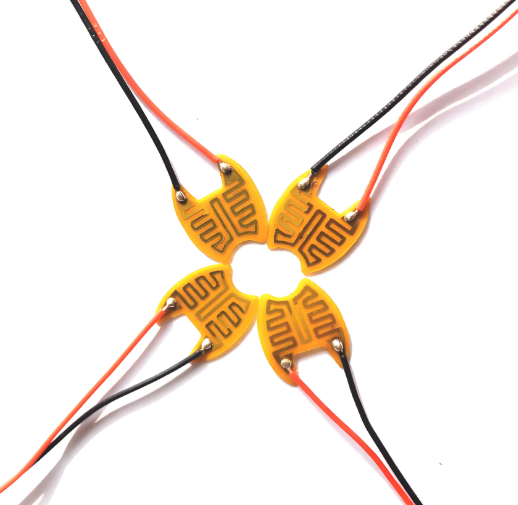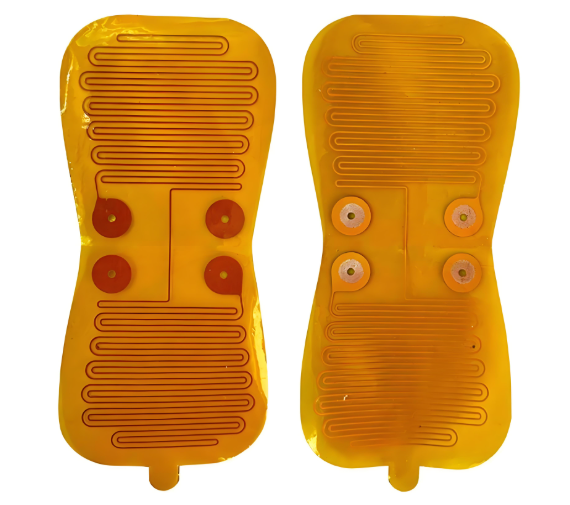Polyimide (PI) heaters are widely used in industries that demand precise and stable heating. Known for their flexibility, thin structure, and excellent insulation, these heaters are common in electronics, medical devices, aerospace equipment, and lithium battery systems.
However, many engineers often ask a key question — can a PI heater operate above 150°C? This article will explore how PI heaters work, their temperature limits, and what options are available for higher heat requirements.

A PI heater is a flexible heating element made by etching a thin metal foil (often copper or nickel alloy) into a specific circuit pattern, then laminating it between layers of polyimide film.
When voltage passes through the metal circuit, it converts electrical energy into heat. Because polyimide has excellent dielectric strength and thermal stability, the heat spreads evenly across the surface. The thin profile of the film ensures fast response and efficient thermal transfer.
PI heaters are often used in applications where space is limited or precise temperature control is critical.
A typical PI heater consists of three main components:
Some designs also include pressure-sensitive adhesive (PSA) for easy installation on target surfaces.

In most cases, a standard PI heater is made from polyimide film laminated with an etched foil circuit, usually copper or nickel alloy. These heaters are stable, compact, and capable of precise heating control.
The recommended continuous working temperature is below 130°C, while short-term exposure can reach up to 150°C. Within this range, the heater maintains excellent insulation and mechanical strength without delamination or performance loss.
Although PI heaters have impressive heat tolerance, several technical barriers prevent them from operating stably above 150°C:
Because of these reasons, PI heaters are generally not suitable for continuous operation above 150°C under normal conditions.
Yes, but they are still under development and testing. Advanced material suppliers are experimenting with enhanced polyimide films that can maintain stability beyond 150°C and potentially reach 200°C or higher.
However, this improvement also requires compatible adhesives, etching materials, and production equipment capable of handling such conditions. Until these materials become standardized and reliable, mass production of high-temperature PI heaters remains challenging.
When a PI heater exceeds its rated temperature for too long, several issues can occur:
In extreme cases, continuous overheating could result in short circuits or insulation breakdown. That’s why proper temperature control is essential when operating near the upper limit.

The key difference lies in material composition and manufacturing tolerance.
Standard PI film supports long-term operation up to around 130°C, with short bursts to 150°C.
High-temperature PI film, on the other hand, is made using advanced formulations designed to endure 200°C or higher.
However, high-temperature-grade PI films are still in the research and testing phase. Besides, the entire lamination process must also handle these extreme conditions to maintain durability.
If your application requires higher temperatures or needs to handle frequent thermal cycling, silicone rubber heaters are a better choice.
Silicone heaters can typically:
They are ideal for industrial, automotive, and outdoor heating applications where PI films would be less stable.
Yes. PI heaters are often paired with thermistors, RTDs, or thermocouples for precise temperature feedback.
By integrating these sensors, the heater can be connected to a temperature controller that regulates power output automatically. This helps prevent overheating and maintains stable performance, especially when working near the temperature limit.
Such designs are commonly used in battery warming pads, camera modules, and laboratory instruments.
To ensure safe and stable operation, follow these essential practices:
Proper installation and controlled operation will greatly extend the heater’s service life.
Currently, standard PI heaters are safe for long-term use below 130°C and short-term peaks up to 150°C.
Operating above that range is only possible with special high-temperature PI materials, which are still being tested and not yet available for large-scale production. If your application requires a higher temperature range, silicone rubber heaters are a more dependable solution.
At Danyu electronics, we continue to explore advanced PI materials and fabrication methods for next-generation flexible heaters. Our engineering team ensures every heater offers precise control, long service life, and consistent reliability — no matter the application.
1. What is the maximum continuous working temperature of a PI heater?
Most standard PI heaters can operate continuously up to 130°C, with short-term operation up to 150°C.
2. Can PI heaters be customized for higher temperatures?
Yes, but this requires special high-temperature polyimide films and heat-resistant adhesives, which are still under testing and not yet mass-produced.
3. What heater types are better for temperatures above 150°C?
Silicone rubber heaters are currently the most common alternative, supporting up to 200°C continuous and 230°C short-term operation.
4. Why can’t regular PI heaters exceed 150°C?
Because the film and adhesive layers begin to degrade under prolonged heat, affecting insulation, stability, and overall safety.
5. Where can I get reliable PI or silicone heaters for industrial use?
You can contact Danyu electronics, a professional PCB and flexible heater manufacturer, providing customized PI and silicone heating films with rigorous quality control and global delivery support.
Simply drop your email or phone number in the contact form, and we'll promptly reply you shortly.